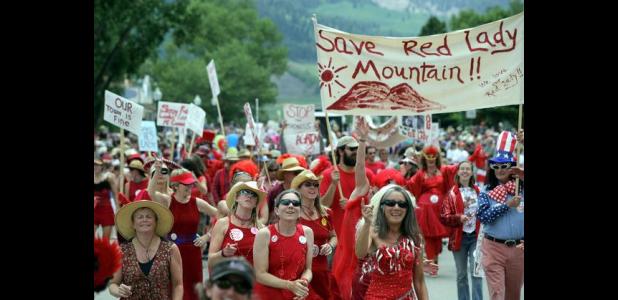An environmental group turns 40
Will Shoemaker
Times Editor
It was 1981. The molybdenum market had tanked, and AMAX put its plans on the back burner for development of a mine on the mountain known affectionately as the Red Lady just outside town.
Many in Crested Butte were ecstatic. Sue Navy had just joined the board of directors of the local environmental organization — known at the time as High Country Citizens’ Alliance. One of her first duties involved organizing a celebration on top of the mountain that would become the battleground of a four-decade-long fight between mining companies and townspeople, as the community increasingly left its ore-producing roots in the dust in favor of a new, tourist economy.
“They were gone, and we hoped for the best, but we knew the mining claims still existed and someone could take over and try again,” Navy recalled.
These days the environmental group — formed officially in 1977 — goes by the name High Country Conservation Advocates (HCCA). But the issue that gave rise to it all appears to be on the verge of vanishing. Last month, Crested Butte passed a ballot measure allowing the town to bond for a payment to the property’s current owner in exchange for the permanent withdrawal of claims necessary to bring a mine to fruition.
It begs the question: What will become of HCCA as it nears its 40th anniversary?
Mine only part of the mission
From working to block clear-cutting of aspen trees near Kebler Pass to designation of new wilderness areas, HCCA has been at the forefront of environmental activism in Gunnison County.
Early on, HCCA founders discussed whether they wanted to be a single-issue group focused on the mine or broaden their scope of activism.
“We were always intending to be available for whatever else might happen and need community input,” Navy said.
Over the years, that’s entailed creation of programs focused on water, public lands, climate change and other topics of local relevance.
Yet, the group’s positions on ski area expansion, spruce beetle response and fat bike grooming, to name a few, have resulted in criticism at times for being obstructionist.
Current board President Sandy Shea joined HCCA has public lands director in 1997. A professional archeologist out of college who banged nails in Boulder and sat behind a sewing machine at a climbing gear company, Shea was part of a group working to save old-growth forest in southwest Colorado when he met longtime Buttian Denis Hall, and moved to Crested Butte at Hall’s beckoning.
Shea oversaw the public lands program until 2005. Since then, he’s gone back to school and earned an ecopsychology degree — a field focused on the relationships between humans and nature — from Naropa University in Boulder. With that comes a perspective that the role for an organization such as HCCA is only increasing — particularly in light of threats like climate change.
“What does that mean for the tourist economy and fire danger? What does that mean for water quantity, water storage, snowfall, avalanche danger?” Shea posed. “I think as a community now, HCCA may play an increasing role in a collaborative way, in trying to draw folks together that frankly might not have been that good at talking to one another. And we’re certainly eager to play that role when it comes to environmental issues.”
‘We’re a resource-rich county’
HCCA’s current staff is young — 35 or younger — and energetic. On the other hand, the group’s board — of which Navy is still a member — some might say is seasoned and wise. The result: institutional knowledge and wisdom guiding a go-getter group of young professionals.
Brett Henderson landed in the Gunnison Valley after a college friend beckoned him north from Texas for a fly fishing trip.
“I was really blown away by public lands in the West,” he admitted. “I had never really experienced what that truly meant.”
Henderson enrolled at Western State Colorado University to complete an accounting degree. Shortly after he was hired by HCCA and since has overseen the nonprofit’s finances — recently becoming executive director.
When he came to HCCA six and a half years ago, natural gas development and coal didn’t consume near as much of the group’s attention as they do today.
“At times it almost seems like there’s too much to do,” said Henderson. “The public lands work is ever-increasing. There’s no slowing that down. As resources become more and more finite, people start looking — where else can we do things — and we’re a resource-rich county.”
Walking between two worlds
That on top of a growing number of visitors to the area combined with climate challenges and a new presidential administration that has pledged to loosen environmental regulations leads HCCA leaders to believe that their watch-dog role will only grow in the future.
How will that be accepted? It’s no secret that the organization is a frequent target for the positions it’s taken.
Board President Shea is quick to look past the criticism, pointing instead to the partnerships that HCCA has formed — with local governments, land managers and other nonprofits.
“Being an advocate for the environment, we walk between two worlds — between the natural world and the human world,” he offered. “We must communicate in the human world, but we must also be very mindful of what’s happening in the natural environment.”
HCCA’s role may be shifting — particularly if Red Lady is rescued, once and for all — but that’s nothing new for the group.
“There’s going to be no end to things that threaten our environment,” longtime board member Navy opined. “We’ll just keep on doing what we do. Like other organizations, the issues change but the work continues.”
(Will Shoemaker can be contacted at 970.641.1414 or editor@gunnisontimes.com.)


